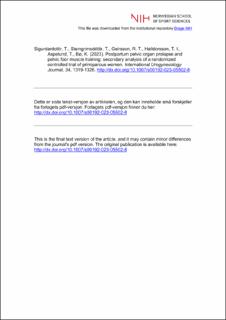| dc.contributor.author | Sigurdardottir, Thorgerdur | |
| dc.contributor.author | Steingrimsdóttir, Thora | |
| dc.contributor.author | Geirsson, Reynir T. | |
| dc.contributor.author | Halldorsson, Thorhallur I. | |
| dc.contributor.author | Aspelund, Thor | |
| dc.contributor.author | Bø, Kari | |
| dc.date.accessioned | 2024-03-19T09:32:33Z | |
| dc.date.available | 2024-03-19T09:32:33Z | |
| dc.date.created | 2023-03-31T09:23:56Z | |
| dc.date.issued | 2023 | |
| dc.identifier.citation | International Urogynecology Journal. 2023, 34, 1319-1326. | en_US |
| dc.identifier.issn | 0937-3462 | |
| dc.identifier.uri | https://hdl.handle.net/11250/3123036 | |
| dc.description | I Brage finner du siste tekst-versjon av artikkelen, og den kan inneholde ubetydelige forskjeller fra forlagets pdf-versjon. Forlagets pdf-versjon finner du på link.springer.com / In Brage you'll find the final text version of the article, and it may contain insignificant differences from the journal's pdf version. The original publication is available at link.springer.com | en_US |
| dc.description.abstract | Introduction and Hypothesis: Pelvic floor dysfunction is common after childbirth. We hypothesize that physiotherapist-guided pelvic floor muscle training (PFMT) is effective regarding pelvic organ prolapse (POP) symptoms during the first postpartum year. Methods: This was a secondary analysis from a randomized controlled trial (RCT), carried out at a physiotherapy clinic, Reykjavik. Participants were eighty-four primiparous women with a singleton delivery. They were screened for eligibility 6–13 weeks postpartum. Women in a training group conducted 12 weekly individual sessions with a physiotherapist within an RCT, starting on average 9 weeks postpartum. Outcomes were assessed after the last session (short term) and at approximately 12 months postpartum (long term). The control group received no instructions after the initial assessment. Main outcome measures were self-evaluated POP symptoms by the Australian Pelvic Floor Questionnaire. Results: Forty-one and 43 women were in the training and control groups, respectively. At recruitment, 17 (42.5%) of the training group and 15 (37%) of the control group reported prolapse symptoms (p = 0.6). Five (13%) from the training group and nine (21%) controls were bothered by the symptoms (p = 0.3). There was a gradual decrease in the number of women with symptoms and no significant short-term (p = 0.08) or long-term (p = 0.6) differences between the groups regarding rates of women with POP symptoms. The difference between groups regarding bother in the short (p = 0.3) or longer term (p = 0.4) was not significant. Repeated-measures analyses using Proc Genmod in SAS did not indicate a significant effect of the intervention over time (p > 0.05). Conclusions: There was an overall decrease in postpartum symptoms of POP and bother during the first year. Physiotherapist-led PFMT did not change the outcomes. | en_US |
| dc.language.iso | eng | en_US |
| dc.subject | pelvic floor muscle training | en_US |
| dc.subject | pelvic floor muscles | en_US |
| dc.subject | pelvic organ prolapse | en_US |
| dc.subject | physiotherapy | en_US |
| dc.subject | postpartum | en_US |
| dc.subject | primiparity | en_US |
| dc.subject | quality of life | en_US |
| dc.title | Postpartum pelvic organ prolapse and pelvic floor muscle training: Secondary analysis of a randomized controlled trial of primiparous women | en_US |
| dc.title.alternative | Postpartum pelvic organ prolapse and pelvic floor muscle training: secondary analysis of a randomized controlled trial of primiparous women | en_US |
| dc.type | Peer reviewed | en_US |
| dc.type | Journal article | en_US |
| dc.description.version | acceptedVersion | en_US |
| dc.source.pagenumber | 1319-1326 | en_US |
| dc.source.volume | 34 | en_US |
| dc.source.journal | International Urogynecology Journal | en_US |
| dc.identifier.doi | 10.1007/s00192-023-05502-8 | |
| dc.identifier.cristin | 2138759 | |
| dc.description.localcode | Institutt for idrettsmedisinske fag / Department of Sports Medicine | en_US |
| cristin.ispublished | true | |
| cristin.fulltext | postprint | |
| cristin.qualitycode | 1 | |
